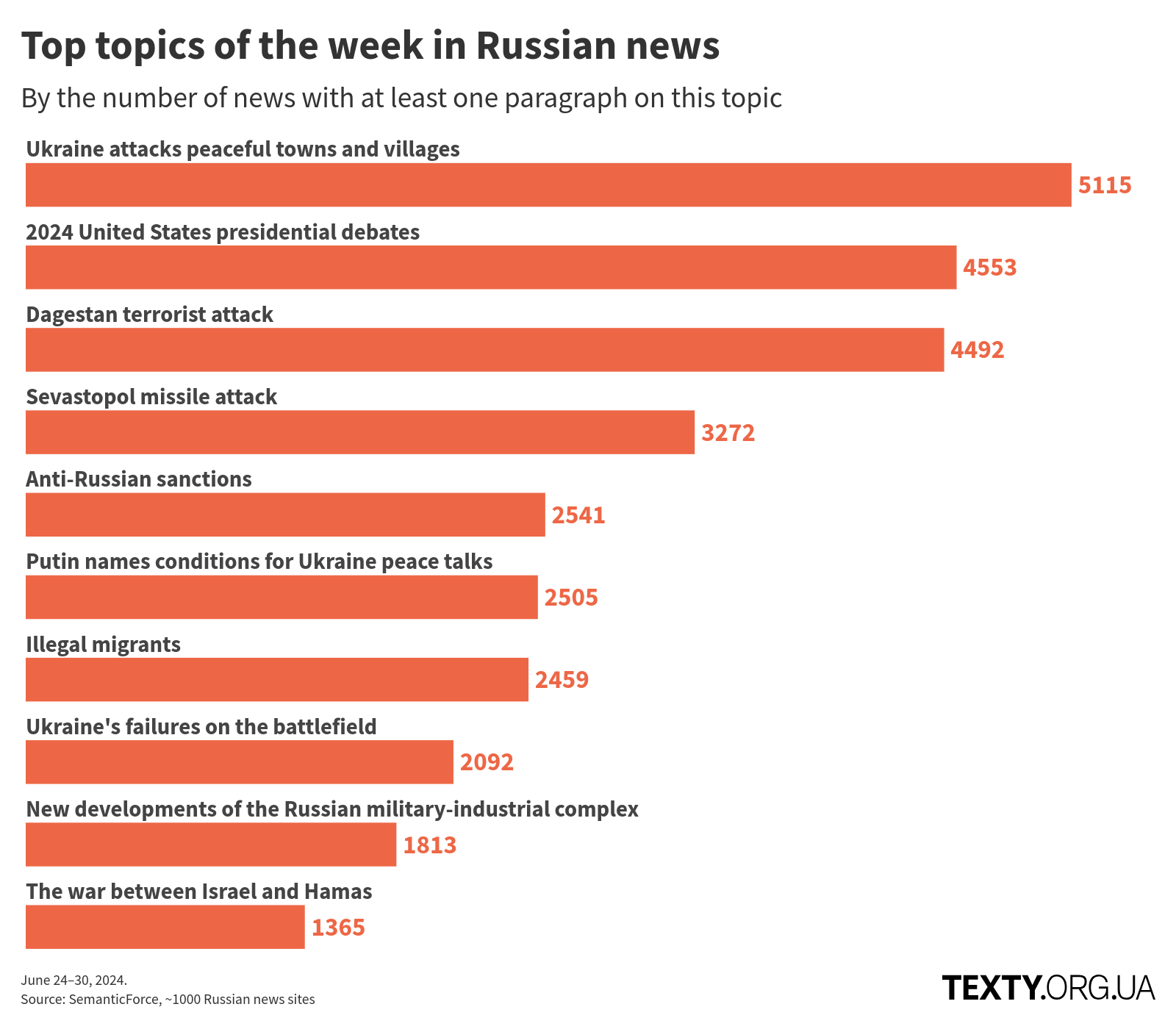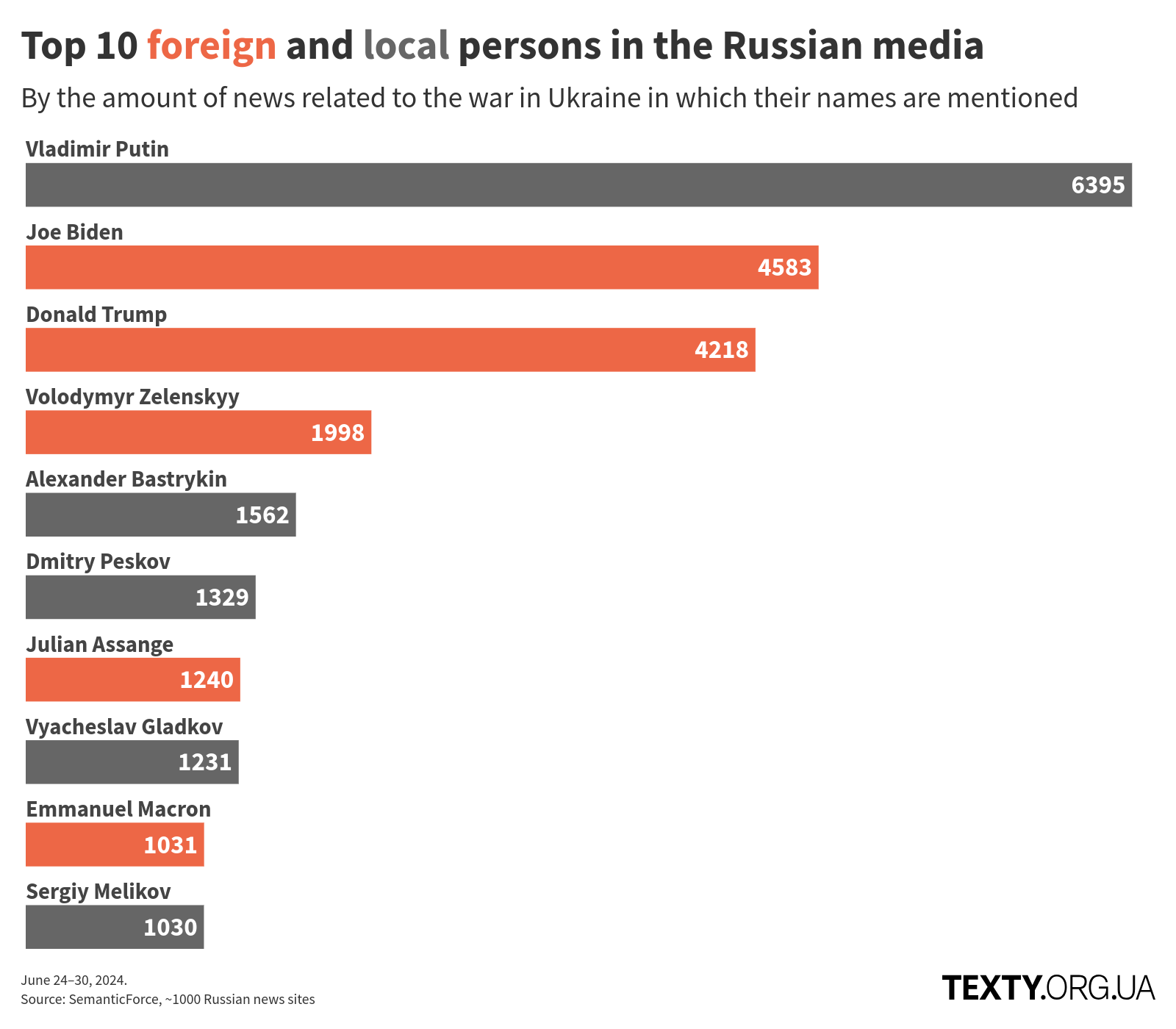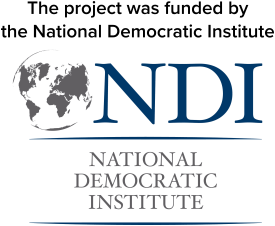Propaganda knows who is responsible for terrorist attacks against Russia. Russian Media Monitoring Report, June 24–30, 2024
Russian media are preoccupied with explaining the terrorist acts by Islamists, which are becoming more frequent in the Russian Federation. The most common version is to link the West and Ukraine to the recent terrorist attack in Dagestan. However, this version sounds very absurd, and some media are trying to analyze the real causes and cite the methods of the head of Chechnya, Ramzan Kadyrov, as an example of solving the problem.

Brief summary of the main points
In March 2024, at the Crocus City Hall concert venue in Krasnogorsk, near Moscow, Islamists shot 140 people. This attack became the deadliest terrorist act in Russia by the number of victims since the Beslan attack in 2004. At that time, propaganda immediately blamed Ukraine and the USA for organizing the attack, although ISIS claimed responsibility, and the shooters were citizens of Tajikistan.
In June, there was a new Islamist terrorist attack in Dagestan. Here, the main perpetrators were Russian citizens, including the children of a local leader. Therefore, propaganda needed to explain why this happened and who the real beneficiary of the tragedy was. The versions vary, but the conclusion is the same. External forces are to blame, as radical Islamism cannot exist in the Russian Federation.
All terrorist attacks in Russia are coordinated by the West, and terrorists are either imported or nurtured by organizations created by the West. Propaganda also creates a template of a good and bad Muslim. If a Muslim supports Putin, then everything is fine with him, but if he does not support the Russian government, he is a potential terrorist.
Read about this and more in the latest issue of our monitoring of Russian state media and manipulative websites that specifically spread Russian disinformation.
Terrorist attacks in Dagestan
On the evening of June 23, militants attacked churches and synagogues in Makhachkala and Derbent. At least 20 people were killed. There were no public statements from the organizers about their motives, but the terrorist group, "Islamic State in the Khorasan Province", praised the attack. According to Serhiy Danilov from the Center for Middle Eastern Studies, it is most likely that the terrorists in Dagestan were an isolated group acting independently.
This is the second Islamist action following the attack at Crocus. Additionally, on June 16, 2024, a group of prisoners associated with the terrorist ISIS took staff members hostage.
In fact, the Russian authorities are facing a wave of terrorist acts. However, it is difficult for them to publicly acknowledge this, as it is for official Russian propaganda. Given the ongoing war against Ukraine, all attention must be focused on anti-Ukrainian and anti-Western propaganda. Recognizing the real enemies and threats to the Russian Federation takes a back seat.
In the immediate aftermath of the Crocus attack, Russia declared the culprits Kyiv and the West. We have written about this in our monitoring reports here and here. This time, propaganda had to work even harder to blame Ukraine, as there were difficulties: the terrorists turned out to be Russian citizens, including children of Russian officials.
Immediately after the attacks in Dagestan, it was revealed that among the attackers were close relatives of the head of the Sergokalinsky district of Dagestan, Magomed Omarov. He was immediately detained and interrogated and later expelled from Putin's party "United Russia."
Propaganda tried to minimize the attention to the citizenship of terrorists. They were referred to as "armed militants," "unidentified people," "bandits," "terrorists," and "militants," and then their ethnic origin was pointed out—Dagestanis. However, they avoided directly stating that these were Russian citizens.
Another issue was to show the causes of the terrorist act. It was necessary to report only what was beneficial to the Russian authorities. The emphasis was placed on the fact that the terrorists were financially well-off people. "Melikov (Sergey Melikov—the head of Dagestan—Ed.): those who organized the terrorist attacks in Makhachkala and Derbent were wealthy people."
To demonstrate that there are no socio-economic problems in Russia. After all, radicalism is often explained precisely by poverty and the lack of rights among citizens. Here, Russian propaganda tries to prove that everything is fine in Russia in this regard.
Propaganda also had to explain where radical Islamism appeared in Russia. The answer is obvious: it is imported. Russian media began tracking the travel routes of the terrorists. Among the tourist destinations, they found Turkey and Saudi Arabia. According to the propaganda, radicalism penetrates Russia from here: "It is actively nurtured thanks to preachers and imams who are trained in Turkey or Saudi Arabia, return home, or broadcast their ideas through social networks. Thus, religious teaching, usually subject to many interpretations, becomes convenient for manipulating communities from a distance. Both Arab, Turkish, and Western intelligence services have long used this."
During the Second Chechen War, Vladimir Putin also repeatedly stated that Chechens were incited to crimes and supported by foreign states.
State Duma deputy Alexei Zhuravlev even declared that radical Islamism never existed in Russia. Terrorists and ideas are specially imported by Russia's enemies.
Propaganda even explains why the terrorist act occurred on a particular date. The organizers supposedly did this to divert attention from an American weapon strike on Sevastopol (more details can be read here) or to strike Russia comprehensively. Russian media list them together: terrorist acts in Dagestan and a terrorist act in Sevastopol.
Regarding the organizers, propagandists have not reached a consensus. Some blame British intelligence services, others American, NATO, or Kyiv: "British intelligence services are behind the serial targeted terrorist acts in Dagestan. This fits into the strategy of controlled escalation. Unfortunately, this will continue. Let's finally fight the West for real," "State Duma deputy from Dagestan Gadzhiev believes that the intelligence services of Ukraine and NATO countries are behind the terrorist act in the republic."
The logic is simple. Ukraine and the West arranged the shooting at the "Crocus," now in Dagestan. And in general, Western intelligence services fuel radical Islamism. Russian media have repeatedly explained that Washington even created Al-Qaeda and ISIS to use them against the enemies of the USA.
However, not all propagandists prefer to define this line as the main one. So far, media and Russian talk shows continue to spread conspiracy theories, where the main culprits in the attacks are Ukraine and the USA. Russian social networks also blame regional leadership.
So-called war correspondents attacked the top leadership of Dagestan: "Dagestan, with alarming regularity, becomes a weak link, helping the enemy make new attempts to shake all of Russia." The leadership was reminded of everything: speeches against anti-coronavirus measures, dissatisfaction with the installation of 5G towers, the plane from Israel blocked by an angry crowd wanting to find Jews there, and, most importantly, protests against mobilization in 2022: "There are no coincidences, no accidental coincidences—the same region repeatedly becomes a hotspot. Coronavirus. 5G towers. Mobilization. The plane from Israel. Attacks on an Orthodox church and synagogue."
The conclusion from such an assessment of the situation is obvious: if people do not support the state line of behavior, then the leadership is to blame and must be changed. Russian officials must implement Putin's policy differently: "It needs to be tougher. Tougher."
As an example, they cite Chechnya and the head of the Chechen Republic, Ramzan Kadyrov. He is called a person who managed to bring order to the republic: "It turns out that they have been fighting radicals in the Caucasus for many years, but only Chechnya really dealt with this issue."
Propagandists especially liked Kadyrov's words that not only potential terrorists but also their relatives should be severely punished: "If there are slightest suspicions (of terrorism), the whole clan should be punished. This clan must know that they bear full responsibility."
Kadyrov is an example of a good Muslim. He supports punishing all those who disagree with the authorities. He mobilizes Chechens for the war against Ukraine.
Here, Russian propaganda also highlights another norm: there are good Muslims who are for Putin and who do not commit terrorist acts: "Kadyrov emphasized in a Telegram post that Muslims do not commit terrorist acts. He noted that terrorists have nothing to do with religion," and there are bad Muslims who criticize the Russian leadership. They are against mobilization; they do not stick the letters "Z" on their cars, and hence, they are potential terrorists.
The events in Dagestan also accelerated the discussion of banning the wearing of niqabs in Russia. A niqab is a Muslim women's head covering that covers the face, with a narrow slit for the eyes. It is very common in Muslim countries. In Russia, although Islam is widespread, it is not the main religion, so wearing a niqab is "not orthodox."
The campaign started with propagandists finding this headgear in the bag of one of the terrorists: "A niqab was found in the bag of one of the terrorists in Dagestan. He planned to use the niqab to escape after the terrorist act." And at the beginning of July, the Muftiate of Dagestan temporarily banned wearing niqabs. The issue of banning this headgear had been debated in Russia for a long time, and the terrorist act in Dagestan became a reason for its acceleration.
What else was written about
Debate between Joe Biden and Donald Trump
Russian propaganda last week watched the televised debates between the U.S. presidential candidates. In Russia, such a competition has long been absent, so the free discussion of candidates is a real action movie: “They haven’t seen each other in four years since the last debates. The degree of mutual hatred is immediately evident.”
Russians awarded the victory to Donald Trump. Russian propaganda “holds their fingers crossed” for this candidate. Indeed, Joe Biden’s performance was not the best. But in the Russian media, this is another reason to predict the collapse of the United States.
Propagandists decided to pay less attention to the content of the speeches and focused on Biden’s health: “With a shuffling gait to his podium, President Biden walked as if to the scaffold.”
They particularly liked Trump's accusations against the Biden family: “Biden does not delay with his main weapon — accusing Trump in a criminal case. In response, Trump reminds everyone about Biden's son and the corruption scandals of the Biden family with the Ukrainian company Burisma.” This is the same Burisma that Russian propaganda accuses of directly financing terrorists.
The story about the Biden family's corrupt connection with the Ukrainian company is always raised by Russian propaganda whenever the American president is mentioned. And here, an American mentioned it, and to all of the United States, so this is another reason for propagandists to repeat their refrain that they always said this, and therefore, it is true.
Release of Assange
On June 26, after pleading guilty in court to violating U.S. espionage laws, WikiLeaks founder Julian Assange was released.

Russian Propagandists Are Extremely Happy About the News. Assange is considered an example of a true journalist to them. "Today, he is free for the first time in many years. Almost free. Despite the terrifying cost, I am extremely happy. The best journalist of our time will live," said Margarita Simonyan, a propagandist from RT (Russia Today). Assange also worked as a host of a show on RT.
Let us recall that Edward Snowden, Assange's follower, whom Assange helped escape from law enforcement after revealing American secret documents, was eventually sheltered by Russia.
Meanwhile, Russian media are speculating on the reasons for Assange's release. For some, it results from secret agreements: "Julian Assange may transfer data on the sources of secret document leaks to the American government. This could involve revealing the names and contacts of informants who leaked secret documents to WikiLeaks." For others, it is a desperate move by Biden to raise his ratings: "The U.S. agreed to leave WikiLeaks founder Julian Assange alone for one reason only: to boost the popularity of Joe Biden and his administration among Democratic and left-wing circles and thereby try to avoid disaster in the November elections."
The example of Assange's imprisonment is also used to explain why the West does not tell the truth to its citizens, while Russia is a paragon of freedom of speech: "The goals pursued by his persecutors have been largely achieved. Few would want to become a truth-seeker at the cost of five years behind bars, endless legal battles ruined health, and the daily expectation of physical violence."
Ukraine attacks peaceful Russian cities and villages
Recently, we have noticed an increase in reports in the Russian media about Ukraine shelling Russian territory. Several factors explain this. Ukraine is using its capabilities more effectively, such as drones targeting military facilities and Russia's energy system. This has to be acknowledged by propaganda, given the burning oil depots. At the same time, Russian media write a lot about Ukraine using Western weapons against Russia. For example, strikes on Belgorod are carried out using the "Vampire" MLRS, and Crimea is being hit with American and British military systems. In this way, propaganda accuses the West of direct attacks on Russia. We will write more about this in our next monitoring of Russian disinformation.
If you are interested in receiving an extended version of our monitoring report, please fill out this brief questionnaire.
The Methodology
To monitor the information published on disinformation websites, we analyzed approximately 500,000 news reports collected from ~ 1,000 Russian websites. The data for the analysis was collected and provided by SemanticForce.
Each paragraph was processed using an algorithm which defines its topic automatically. The resulting topics (i.e. groups with similar content) were short-listed by the topics relating to the war or its consequences for Russia. The number of mentions of a certain topic was then counted for each publication. Our conclusions are based on the respective findings and the quotes from paragraphs referring to each topic.

This article was originally written in Ukrainian. It has been translated into English using AI tools such as DeepL, ChatGPT, and Grammarly. If you encounter an error that requires immediate attention, please inform us via Facebook, Twitter, or Instagram. Your understanding and support are appreciated.

